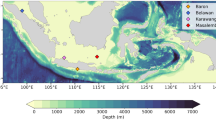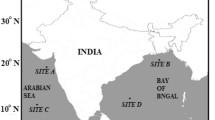Abstract
Accurate simulations of significant wave height (Hs) are extremely important for the safety of navigation, port operations, and oil and gas exploration. Thus, accurate forecasts of Hs are essential for accident prevention and maintenance of services vital to the economy. Considering the limitations of traditional numerical modeling, such as the typical model underestimation of Hs under severe conditions, forecasting Hs using artificial neural networks is a promising method and a complementary approach. In this study we develop a post-processing model using Long Short-Term Memory (LSTM) algorithm to improve outputs from the numerical model WAVEWATCH III (WW3) at Santos Basin, Brazil. The hybrid scheme is focused on the simulations of 1-, 2-, 3- and 4-day residues (difference between observations and WW3) using measurements from a local wave buoy moored in deep water. The results of the hybrid model (WW3+LSTM) show a better performance compared with WW3, being capable of better representing the peak of the events and storms. On average, the gains from using WW3+LSTM reach 3.8% in Correlation Coefficient (CORR), 14.2% in Bias (BIAS), 10.2% in Root Mean Squared Error (RMSE), and 10.7% in Scatter Index (SI). The hybrid model developed allows high-skill forecasts to be carried out on large domains and through longer horizons.








Similar content being viewed by others
Data Availability
The buoy dataset analyzed during the current study is available in the Brazilian National Program repository (https://www.marinha.mil.br/chm/dados-do-goos-brasil/pnboia-mapa). The wind dataset (GFS) used in wave modeling is available in the NCEP repository (https://www.ncei.noaa.gov/products/weather-climate-models/global-forecast).
References
Ardhuin F, Rogers E, Babanin A et al (2010) Semiempirical dissipation source functions for ocean waves. Part I: Definition, calibration, and validation. J Phys Oceanogr 40:1917. https://doi.org/10.1175/2010JPO4324.1
Browne M, Castelle B, Strauss D et al (2007) Near-shore swell estimation from a global wind-wave model: spectral process, linear, and artificial neural network models. Coast Eng 54(5):445–460. https://doi.org/10.1016/j.coastaleng.2006.11.007. http://www.sciencedirect.com/science/article/pii/S0378383906001840
Caires S, Sterl A (2005) 100-year return value estimates for ocean wind speed and significant wave height from the ERA-40 data. J Clim 18(7):1032–1048. https://doi.org/10.1175/JCLI-3312.1. https://journals.ametsoc.org/jcli/article-pdf/18/7/1032/3796666/jcli-3312_1.pdf
Campos R, Guedes Soares C (2016) Hybrid model to forecast significant wave heights: Proceedings of the 3rd International Conference on Maritime Technology and Engineering. MARTECH 2016, Lisbon, Portugal, 4-6 July 2016 pp 1027–1035. https://doi.org/10.1201/b21890-138
Campos RM, Soares CG (2016) Comparison and assessment of three wave hindcasts in the North Atlantic Ocean. Journal of Operational Oceanography 9(1):26–44. https://doi.org/10.1080/1755876X.2016.1200249
Campos RM, Krasnopolsky V, Alves JHGM et al (2019) Nonlinear wave ensemble averaging in the Gulf of Mexico using neural networks. J Atmos Oceanic Tech 36(1):113–127. https://doi.org/10.1175/JTECH-D-18-0099.1. https://journals.ametsoc.org/jtech/article-pdf/36/1/113/3416099/jtech-d-18-0099_1.pdf
Cardone VJ, Jensen RE, Resio DT et al (1996) Evaluation of contemporary ocean wave models in rare extreme events: the “Halloween Storm” of October 1991 and the “Storm of the Century” of March 1993. J Atmos Oceanic Tech 13(1):198–230. https://doi.org/10.1175/1520-0426(1996)013<0198:EOCOWM>2.0.CO;2. https://journals.ametsoc.org/jtech/article-pdf/13/1/198/3297784/1520-0426(1996)013_0198_eocowm_2_0_co_2.pdf
Cavaleri L (2009) Wave modeling-missing the peaks. J Phys Oceanogr 39(11):2757–2778. https://doi.org/10.1175/2009JPO4067.1. https://journals.ametsoc.org/jpo/article-pdf/39/11/2757/4496396/2009jpo4067_1.pdf
Deo M, Naidu CS (1998) Real time wave forecasting using neural networks. Ocean Eng 26(3):191–203. https://doi.org/10.1016/S0029-8018(97)10025-7. http://www.sciencedirect.com/science/article/pii/S0029801897100257
Deo M, Jha A, Chaphekar A et al (2001) Neural networks for wave forecasting. Ocean Eng 28(7):889–898. https://doi.org/10.1016/S0029-8018(00)00027-5. http://www.sciencedirect.com/science/article/pii/S0029801800000275
Dixit P, Londhe S (2016) Prediction of extreme wave heights using neuro wavelet technique. Appl Ocean Res 58:241–252. https://doi.org/10.1016/j.apor.2016.04.011. http://www.sciencedirect.com/science/article/pii/S0141118716301067
Etemad-Shahidi A, Mahjoobi J (2009) Comparison between M5 model tree and neural networks for prediction of significant wave height in lake superior. Ocean Eng 36(15):1175–1181. https://doi.org/10.1016/j.oceaneng.2009.08.008. http://www.sciencedirect.com/science/article/pii/S0029801809001905
Fan S, Xiao N, Dong S (2020) A novel model to predict significant wave height based on long short-term memory network. Ocean Eng 205:107298. https://doi.org/10.1016/j.oceaneng.2020.107298. http://www.sciencedirect.com/science/article/pii/S0029801820303401
Goodfellow I, Bengio Y, Courville A (2016) Deep learning. MIT Press. http://www.deeplearningbook.org
Hashim R, Roy C, Motamedi S et al (2016) Selection of climatic parameters affecting wave height prediction using an enhanced Takagi-Sugeno-based fuzzy methodology. Renew Sustain Energy Rev 60:246–257. https://doi.org/10.1016/j.rser.2016.01.098. http://www.sciencedirect.com/science/article/pii/S1364032116001283
Haykin SS (2009) Neural networks and learning machines, 3rd edn. Pearson Education, Upper Saddle River, NJ
Hochreiter S, Schmidhuber J (1997) Long short-term memory. Neural Comput 9:1735–1780. https://doi.org/10.1162/neco.1997.9.8.1735
Holthuijsen LH (2007) Waves in oceanic and coastal waters. Cambridge University Press. https://doi.org/10.1017/CBO9780511618536
Hornik K (1991) Approximation capabilities of multilayer feedforward networks. Neural Netw 4(2):251–257. https://doi.org/10.1016/0893-6080(91)90009-T. https://www.sciencedirect.com/science/article/pii/089360809190009T
Hu H, van der Westhuysen AJ, Chu P et al (2021) Predicting lake erie wave heights and periods using XGBOOST and LSTM. Ocean Model 164:101832. https://doi.org/10.1016/j.ocemod.2021.101832. https://www.sciencedirect.com/science/article/pii/S1463500321000846
Jörges C, Berkenbrink C, Stumpe B (2021) Prediction and reconstruction of ocean wave heights based on bathymetric data using LSTM neural networks. Ocean Eng 232:109046. https://doi.org/10.1016/j.oceaneng.2021.109046. https://www.sciencedirect.com/science/article/pii/S0029801821004819
Kaiser J, Nogueira ICM, Campos RM et al (2022) Evaluation of wave model performance in the South Atlantic Ocean: a study about physical parameterization and wind forcing calibration. Ocean Dyn 72:137–150. https://doi.org/10.1007/s10236-021-01495-4
Krasnopolsky V (2013) The application of neural networks in the earth system sciences, vol 46. Springer Dordrecht. https://doi.org/10.1007/978-94-007-6073-8_6
Krasnopolsky VM (2014) NN-TSV, NCEP neural network training and validation system; brief description of NN background and training software. Office note 478 (National Centers for Environmental Prediction (US)) pp 1–60. https://doi.org/10.7289/V5QR4V2Z. https://repository.library.noaa.gov/view/noaa/6945
Londhe S, Shah S, Dixit P et al (2016) A coupled numerical and artificial neural network model for improving location specific wave forecast. Appl Ocean Res 59:483–491. https://doi.org/10.1016/j.apor.2016.07.004. http://www.sciencedirect.com/science/article/pii/S0141118716300876
Lorenz EN (1963) The predictability of hydrodynamic flow. Trans N Y Acad Sci 25:409–432
Mentaschi L, Besio G, Cassola F et al (2013) Problems in RMSE-based wave model validations. Ocean Model 72:53–58. https://doi.org/10.1016/j.ocemod.2013.08.003
Minuzzi FC, Farina L (2022) A deep learning approach to predict significant wave height using long short-term memory. Ocean Model 102151. https://doi.org/10.1016/j.ocemod.2022.102151. https://www.sciencedirect.com/science/article/pii/S1463500322001652
Nascimento MX (2013) Analysis of meteoceanographic conditions in the Santos Basin Region. Master’s thesis, Federal University of Rio de Janeiro
Olah C (2015) Understanding LSTM networks. http://colah.github.io/posts/2015-08-Understanding-LSTMs/
Reboita MS, Gan MA, Rocha RPArd et al (2010) Precipitation regimes in South America: a literature review. Brazilian Journal of Meteorology 25:185–204. https://doi.org/10.1590/S0102-77862010000200004. http://www.scielo.br/scielo.php?script=sci_arttext &pid=S0102-77862010000200004 &nrm=iso
Silva I, Spatti D, Flauzini R (2010) Artificial neural networks for engineering and applied sciences. Artliber
Sun D, Huang W, Luo Y et al (2022) A deep learning-based bias correction method for predicting ocean surface waves in the Northwest Pacific Ocean. Geophys Res Lett 49(23):e2022GL100,916. https://doi.org/10.1029/2022GL100916. https://agupubs.onlinelibrary.wiley.com/doi/abs/10.1029/2022GL100916, e2022GL100916 2022GL100916
Tolman H, Accensi M, Alves JH et al (2014) User manual and system documentation of WAVEWATCH III version 4.18. U. S. Department of Commerce National Oceanic and Atmospheric Administration National Weather Service National Centers for Environmental Prediction
Wang W, Tang R, Li C et al (2018) A BP neural network model optimized by mind evolutionary algorithm for predicting the ocean wave heights. Ocean Eng 162:98–107. https://doi.org/10.1016/j.oceaneng.2018.04.039. http://www.sciencedirect.com/science/article/pii/S0029801818305213
Acknowledgements
The authors thank Coordenação de Aperfeiçoamento de Pessoal de Nível Superior - Brasil (CAPES) - (Finance Code 001) for the student fellowship of the first author and CNPQ (PQ-2308078/2019-5) for the grant to the third author. The second author is funded by the Cooperative Institute for Marine and Atmospheric Studies (CIMAS), a Cooperative Institute of the University of Miami and the National Oceanic and Atmospheric Administration, cooperative agreement NA20OAR4320472. The authors also thank Oceanographic Instrumentation Laboratory (LIOc) for providing the wave modeling data.
Author information
Authors and Affiliations
Contributions
Paula Marangoni Gazineu Marinho Pinto: conceptualization, methodology, formal analysis and investigation, writing — original draft preparation. Ricardo Martins Campos: conceptualization, methodology, writing — review and editing. Marcos Nicolas Gallo: conceptualization, methodology, writing — review and editing, funding acquisition, supervision. Carlos Eduardo Ribeiro Parente: conceptualization, methodology, funding acquisition, supervision.
Corresponding author
Ethics declarations
Competing interests
The authors declare no competing interests.
Additional information
Responsible Editor: Amin Chabchoub.
Publisher's Note
Springer Nature remains neutral with regard to jurisdictional claims in published maps and institutional affiliations.
Rights and permissions
Springer Nature or its licensor (e.g. a society or other partner) holds exclusive rights to this article under a publishing agreement with the author(s) or other rightsholder(s); author self-archiving of the accepted manuscript version of this article is solely governed by the terms of such publishing agreement and applicable law.
About this article
Cite this article
Marangoni Gazineu Marinho Pinto, P., Martins Campos, R., Gallo, M.N. et al. Predicting significant wave height with artificial neural networks in the South Atlantic Ocean: a hybrid approach. Ocean Dynamics 73, 303–315 (2023). https://doi.org/10.1007/s10236-023-01546-y
Received:
Accepted:
Published:
Issue Date:
DOI: https://doi.org/10.1007/s10236-023-01546-y




